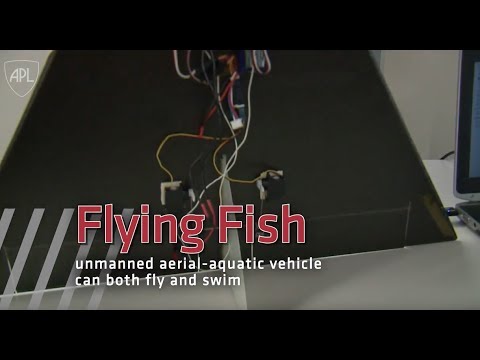Press Release
Water and Air: Flying Fish UAAV Can Go Anywhere

Credit: APL
About two and a half years ago, Joe Moore, Eddie Tunstel and Robert Osiander — robotics researchers in the Research and Exploratory Development Department of the Johns Hopkins Applied Physics Laboratory — had an idea: create a fixed-wing, unmanned vehicle that could autonomously operate underwater and then propel itself fast enough to make the transition into the air, becoming an autonomous flying aerial vehicle.
However, little work had been done to develop such a platform, known as a fixed-wing Unmanned Aerial-Aquatic Vehicle (UAAV). To study how such a UAAV might work, they looked to one of nature’s unique multi-domain creatures: the peculiar animal known as the flying fish.
Their concept vehicle — now dubbed Flying Fish — became an independent research and development proposal, and eventually a working prototype.
“Our challenge was to see if we could use a single motor propeller combination to be able to achieve water-to-air transition,” said Moore.
Flying fish have the unique capability to make self-propelled leaps out of water and into the air, where their long, wing-like fins enable them to glide long distances. Moore noticed how the fish build up enough speed under the water to break the surface and then often continue to expend energy during the water-to-air transition to achieve flight speed.
Much like the tail of the flying fish, the propeller on the Flying Fish UAAV continuously imparts a thrust force to the vehicle during the water-to-air transition. Once airborne, the UAAV operates like a traditional fixed-wing aircraft. By appropriately adjusting the speed of the propeller based on whether the vehicle is in water or air, the vehicle is able to use a single propulsion mechanism to enable effective locomotion within both domains.
Although the Flying Fish prototype does not yet include a payload for environmental sensing, the concept is for the UAAV to fly itself to a land-locked body of water and then go underwater to collect data. The UAAV can fly in at about 30 miles an hour, dive into the water, collect information and perform reconnaissance, then launch out of the water and return the data.
Envisioned sensor packages include an onboard camera, which can be accessed by the operator when the vehicle returns to base.
The Flying Fish can also rapidly sample multiple locations in a large body of water. Instead of traveling underwater, it flies between points, providing a much faster means of collecting information.
“As we developed Flying Fish and saw the kinds of capabilities a UAAV brought, we began to envision new missions it could undertake,” said Will Setzler, a composite technician in the Force Projection Sector, who contributed significantly to the project. “We also started to see new, more effective ways for it to perform existing missions.”
